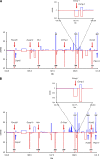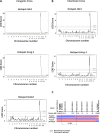Trans-regulation of mouse meiotic recombination hotspots by Rcr1
- PMID: 19226189
- PMCID: PMC2642880
- DOI: 10.1371/journal.pbio.1000036
Trans-regulation of mouse meiotic recombination hotspots by Rcr1
Abstract
Meiotic recombination is required for the orderly segregation of chromosomes during meiosis and for providing genetic diversity among offspring. Among mammals, as well as yeast and higher plants, recombination preferentially occurs at highly delimited chromosomal sites 1-2 kb long known as hotspots. Although considerable progress has been made in understanding the roles various proteins play in carrying out the molecular events of the recombination process, relatively little is understood about the factors controlling the location and relative activity of mammalian recombination hotspots. To search for trans-acting factors controlling the positioning of recombination events, we compared the locations of crossovers arising in an 8-Mb segment of a 100-Mb region of mouse Chromosome 1 (Chr 1) when the longer region was heterozygous C57BL/6J (B6) x CAST/EiJ (CAST) and the remainder of the genome was either similarly heterozygous or entirely homozygous B6. The lack of CAST alleles in the remainder of the genome resulted in profound changes in hotspot activity in both females and males. Recombination activity was lost at several hotspots; new, previously undetected hotspots appeared; and still other hotspots remained unaffected, indicating the presence of distant trans-acting gene(s) whose CAST allele(s) activate or suppress the activity of specific hotspots. Testing the activity of three activated hotspots in sperm samples from individual male progeny of two genetic crosses, we identified a single trans-acting regulator of hotspot activity, designated Rcr1, that is located in a 5.30-Mb interval (11.74-17.04 Mb) on Chr 17. Using an Escherichia coli cloning assay to characterize the molecular products of recombination at two of these hotspots, we found that Rcr1 controls the appearance of both crossover and noncrossover gene conversion events, indicating that it likely controls the sites of the double-strand DNA breaks that initiate the recombination process.
Conflict of interest statement
Competing interests. The authors have declared that no competing interests exist.
Figures





References
-
- de Massy B. Distribution of meiotic recombination sites. Trends Genet. 2003;19:514–522. - PubMed
-
- Baudat F, de Massy B. Regulating double-stranded DNA break repair towards crossover or non-crossover during mammalian meiosis. Chromosome Res. 2007;15:565–577. - PubMed
-
- Allers T, Lichten M. Differential timing and control of noncrossover and crossover recombination during meiosis. Cell. 2001;106:47–57. - PubMed
-
- Hunter N, Kleckner N. The single-end invasion: an asymmetric intermediate at the double-strand break to double-holliday junction transition of meiotic recombination. Cell. 2001;106:59–70. - PubMed
Publication types
MeSH terms
Substances
Grants and funding
LinkOut - more resources
Full Text Sources
Molecular Biology Databases
Miscellaneous

